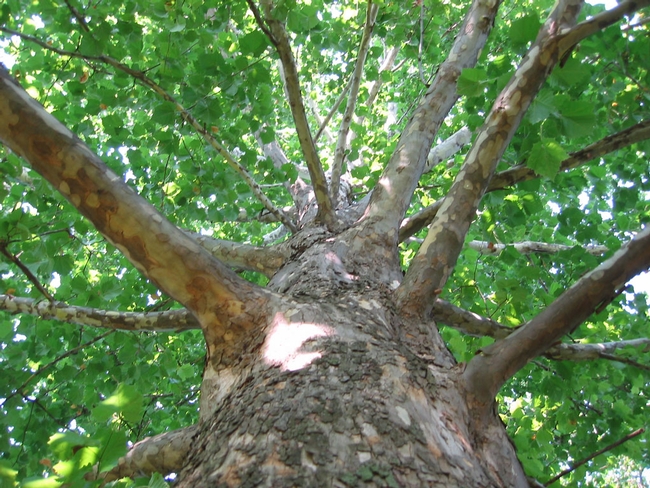
Posts Tagged: polyphagous shot hole
Invasive Spotlight: Shot Hole Borers and the Diseases They Carry
Shot hole borers are tiny insects the size of a sesame seed that don't look particularly harmful,...

Poster
Loss of trees could portend loss of human life
An invasive pest from Asia is killing thousands of trees in Southern California, which may lead to the death of thousands of humans, reported Adam Rogers on Wired.com.
Polyphagous shot hole borer females drill holes inside trees to lay their eggs. In the process, they deposit a fungus that grows and provides food for larvae. The fungus gums up the trees' channels for water and nutrient transport, eventually killing it. Called Fusarium dieback, the condition is on track to kill 26.8 million trees across Southern California in the next few years.
With data from a U.S. Forest Services study, which found that fewer trees is related to respiratory and cardiovascular disease deaths in people, the reporter underscored the dire human-health implications of polyphagous shot hole borer.
Trees also provide valuable "ecosystem services," such as reducing light and heat intensity, protecting water, cleaning the air of pollutants, providing wildlife habitat and storing carbon. The forest service combined satellite data and field plot data to calculate the costs and benefits of trees. The potential loss of ecosystem services because of polyphagous shot hole borer is $1.4 billion, not including the public health cost.
“A normal response to an invasive pest means millions of dollars would be thrown at it,” said John Kabashima, UC Cooperative Extension advisor emeritus who is working on staving off a catastrophe. “This one has received hundreds of thousands.”
Kabashima and other scientists are identifying infected trees to cut them down and chip the wood to prevent further spread. The tell-tale signs are little holes and sugar volcanoes that tend to show up first on the north side of the trunk or limb.
"You have to get out and walk around each tree, which we're doing in Orange County parks," Kabashima said. "We go out on off-road Segways. We can cover square miles in a day."
UC Cooperative Extension uses UC Irvine campus as a living lab

"The beauty of UCI is that it's a university, and they're used to researchers," said John Kabashima, an environmental horticulture advisor and entomologist with the UC Cooperative Extension in Orange County.
Another scientist on the project is Akif Eskalen, UC Cooperative Extension plant pathology specialist based at UC Riverside. Eskalen first identified the sesame seed-sized beetle in a South Gate avocado tree in 2012.
Eskalen selected 130 sycamores at UCI for his experiment and divided them into 13 groups of 10. Four of the groups were treated with different insecticides; three were treated with different fungicides; and four others got one of each. Another group was given a beneficial bacteria found in some California trees that's thought to kill the fungus. A final group is serving as a control and received no treatment at all.
The scientists are allowed to cut down and section the trees, sample them, and even leave some infested trees alone. Having this flexibility is essential to understanding the success — or failure — of a given pesticide, Kabashima said: "That's why we're learning so much here at UCI."
UC Irvine gets landscape tree help from UC ANR

Polyphagous shot hole borer has been present on the campus for two to three years. The extent of the infestation became apparent in the last few months when a significant number of trees began showing severe symptoms. UCI groundskeepers began to more closely examine a number of trees that appeared to be particularly distressed and worked with UC ANR staff to identify PSHB in early 2015.
A team of UCI staff qualified in tree management is receiving training from UC ANR (UC Riverside and UCCE) to properly identify and assess PSHB infestation. The team will monitor all trees on the UCI campus and, with input from faculty and students from UCI's Center for Environmental Biology, make the determination about which infected trees will be removed.
The news release suggests area property owners who suspect their own trees are infested with PSHB contact John Kabashima, UC ANR environmental horticulture advisor at the UC South Coast Research and Extension Center, 7601 Irvine Blvd., Irvine, CA 92618, pshb.ucce.oc@gmail.com.
Sesame seed-size insect is victimizing trees in Southern California

Akif Eskalen, UC Cooperative Extension plant pathology specialist at UC Riverside, wants to contain this invasive bug before it spreads throughout Southern California.
"If we can't control them," Eskalen said, "they are going to wipe out all our trees."
Box elders, sycamores, American sweetgum, maple and coast live oaks are susceptible to polyphagous shot hole borer attack. In urban and suburban areas, the dead and dying trees can pose fire and limb falling dangers. In the agricultural sector, avocado trees could face huge financial losses. In the fight against the pest, the California Avocado Commission has provided Eskalen $800,000 to broaden his investigation into this mysterious species of ambrosia beetle.
In March, Eskalen and his colleagues - UC Riverside entomologist Richard Stouthamer and Huntington Library curator of woody collections Tim Thibault - spent two weeks in Vietnam, where PSHB originates, searching forests and fields for natural enemies of the fungus spread by the pest. They collected a host of possible allies, whose DNA is now being analyzed in the lab.
"I am very hopeful that we are going to find some solutions to control this fungus," Eskalen said. "We have to."

